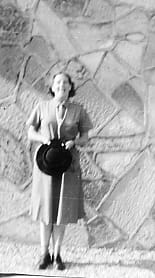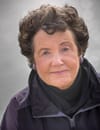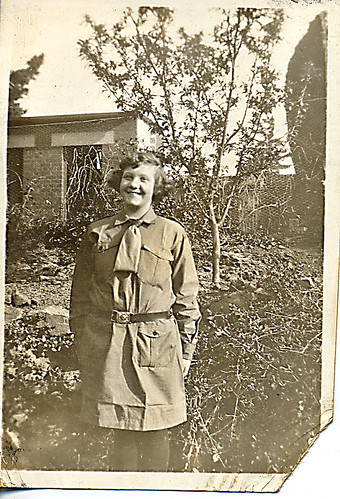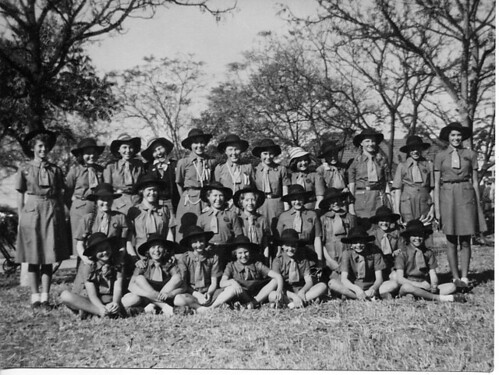A Uniform of a Different Sort

Mom, in her Prime
A Uniform of a Different Sort
As you recall in last weeks blog I hoped that I would fit in at school wearing a school uniform like everyone else. My mother too believed in uniforms as a great equalizer.
A Uniform of a Different Sort
The sun shines bright and hot from the ever blue African sky. The Girl Guide gold trefoil badge symbolized the sun shining over everyone in this bright blue world of ours. In reality, of course our part of Africa was segregated much like the United States at that time. Mom believed she could make a difference to our world through the movement. She wasn’t new to Guiding. She had been a Girl Guide since she was twelve years old in South Africa and was still as enthusiastic in the prime of her life.
When I was a Brownie in the Elf Patrol, I would watch her transformation from doctor’s wife and mommy and housewife and mayoress, to Brown Owl and Guide Captain, as she donned the blue of the Girl Guide uniform with its practical breast and skirt pockets. She folded her kerchief, neatly pulled it tight and pinned it down with the three leaved trefoil. There were two stars cut out of it symbolizing the Girl Guide Law and Promise. She always polished the badge with Brasso and brushed it up with an old toothbrush before meetings. She wanted it to shine in Africa, with its compass needle pointing the way.
Finally, she would turn down her white socks, lace up her sensible brown shoes and slip the lanyard and whistle over her neck. She looked critically in the mirror before stepping out to take charge. She wanted every girl, European, Native and Coloured, to experience the opportunities and joys Guiding had afforded her as a child.
Camping, embracing the great outdoors, was something that went hand in hand with Guiding. After all, Baden Powell had perfected his woodcraft skills here in the Matopos Hills during the Matabele Campaign of 1896 under the tutelage of the American Frederick Russell Burnham.
Camping too was a great equalizer: combining Guiding and camping could be no better character builder. Inter-Racial Camping was the goal but first she started with the Europeans. She got a hold of some WWII army bell tents.
Que Que was barely out of the bushveld itself. So Mom had only to ask A.E. Davies the chemist if the Guides could camp on the fringes of their plot in Hillandale, a couple of miles from town, where monkeys still swung from the mountain acacia, msasa, mufti, and mnondo trees by day and leopards stalked at night.
Having said that, Que Que was growing fast. From a mere appendage to the famous Globe and Phoenix Mine, Dad was working hard on his vision to make Que Que the industrial hub of Rhodesia, which was reported on at length at the dinner table each evening along with his surgical challenges. It was amazing the opposition there was to progress in Que Que let alone the practical obstacles. We’d be well into pudding before Dad enquired what had taken up Mom’s day, and she’d usually dismiss it with the last mouthful and a wash down of tea.
The amazing thing was that with all the patients coming and going through the surgery door, Dad did not hear about the upcoming debut of Girl Guide camping until Al Davies phoned about a prescription. In his Welsh brogue, he said, “My wife and I are very happy to have the Guide camp this weekend. Shall we expect you as well? Perhaps on Sunday afternoon, for tea?”


